#and beyond that my use of description is often more abstract than strictly visual
Explore tagged Tumblr posts
Text
Joshua Dildine Interview
The Joshua Dildine Interview is finally here. We take a deep dive into the duality of his work, the friction and synthesis between instinct and intellect.
Cave paintings made of poop, sci-fi and spirituality along with the otherworldliness permeating through his oeuvre, are all explored as I probe to get a better understanding of what drives his mysterious, yet familiar, compositions. Read along to see how these seemingly paradoxical elements come together, as past, present and future merge.
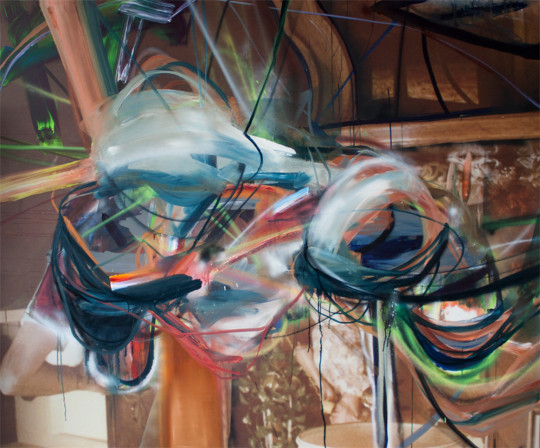
Joshua Dildine, Life Well Lit, 2012
PB: Hey Joshua, thank you for taking the time to do this. Your work is so viscerally powerful I feel like words almost become redundant, but in any case I've had a strong urge to talk to you to learn more about the dimensions you open up. One of the things that struck me when watching some of the interviews you've done, is how down to earth and level-headed your approach seems to be, in contrast to your works, which strikes me as being almost out of this world in terms of space and language. More often than not, I find the opposite to be true in a lot of artists, where the lucid descriptions of the work fall flat in comparison to the external reality of forms. In that sense I found it quite refreshing to see your humble approach, and it made me even more curious about your philosophy and how you approach art in a general sense.
It seems as though you came across your style, for lack of a better term, as we know it today in 2011. And I was wondering how your personal perception of it have changed and evolved in the past 6 years? I know it's a broad question, so feel free to highlight what you find most interesting and, or, surprising in the course of this development.
JD: I am really a pretty down-to-earth guy, despite what my paintings may say about me. Ive always been interested in creating atmosphere and depth in abstract painting. My personal perception has changed quite a bit ever since I started painting over photos in 2011. I started doing it as a somewhat sarcastic response to some criticism I had to my work prior to the photos; something about the work was not personal enough. So in a humorous effort to make it personal, I painted over a photo of my face. I continued to do this and started pulling from other family photos. I realized that there was an inherit power that the images had over me, as well the people that I was painting over. For example, when I pulled my parents engagement photo off the wall and painted over it, my mom was pissed. She initially didn’t realize that I’d scanned the original and reprinted it to paint over the copy, and even then was slightly disturbed by the act. There was a connection there that was more powerful that just a painted ground to work over. Another thing I realized at this time, was scribbling out the faces of my parents was not easy. In other words, my personal attachment to the subjects made it hard to scribble their image out. So in the earlier work, my intention was to deny the power of the image and use it as a visual armature from which to create my paintings.
As I continued to work through this process, the idea remained as an undertone, but not the main idea that pushed the work forward. I started to focus on the visual language that the photographs contained (depth of field, light source, lens flair, motion blur, color deterioration, color, atmosphere). I was using photographic means, and still do, to answer questions of abstraction (borrowing that idea from David Reed). In contrast, I set out to answer photographic questions through abstract means. I started embellishing elements of the photographs that would confuse the space. I was reading a lot of sci-fi, Orson Scott Card at the time, and had “antigravity” on the brain. Gravity has more power in photography than abstract painting, so in a way to deny those "powers" as well, I would switch the orientation to provide influence to the composition.
The word "defacement" got old and outdated pretty fast. I was no longer interested in that conversation. The gestures themselves could change the way we perceive the intention behind the act of painting over someone. If I took a thin brush, pen, or pencil and "scribbled" out the faces in fast lines, it reads aggressive and hostile. If I have a thick blob looking gesture it is a lighter color, done slowly, intentionally, it’s a less hostile read.
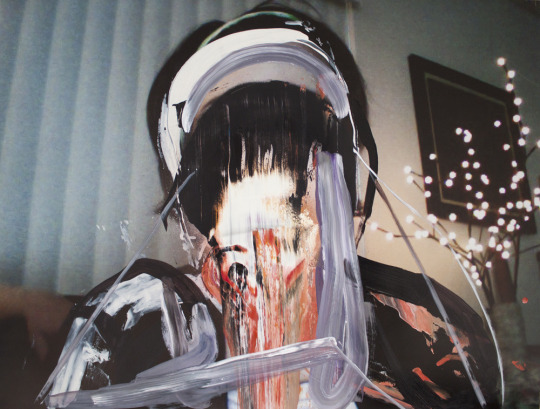
Joshua Dildine, Rediscover Delicious Harmony, 2011
PB: The dangers of being pigeonholed is like a mine field when establishing your work, I guess, so it seems like a good idea to proactively avoid the traps that reveal themselves early on. Can you elaborate a bit on how you steered the evolution of your work in that regard?
JD: The way I view the power that images have changes with each image I choose. I couldn't say that to a white canvas. Using photographs as a ground has a multi-faceted advantage for me; there is an emotional response to the act, then there is the strictly visual challenge of being presented with questions to answer with paint. And now, there is a possessive point of pride that the subjects of the photographs have with the paintings. As if they were portraits. My siblings refer to a painting as their own, when it has an image of them underneath. “How many of Matt, or Taylor, or so-and-so are in this show?”, might be a conversation we have leading up to an exhibition.
At this point, I have been reevaluating what I've been doing and have discovered another aspect to interacting with the photos I had not expected. Over a year and half ago we moved to my hometown to take over my grandparents’ house. The act of moving into a house that you have a historical connection with, changing it and making it your own, in some ways is the same thing I have been doing to the photos. There were boxes and boxes of old family photos and slides when we moved in from generations beyond my memory, as well as some relics of furniture and trinkets. Using these to work from connects me to the people that owned them, but the fact that I’m living in the space provides little differentiation between my life and the work. I am constantly re-evaluating what makes my work so personal, and drawing from that.
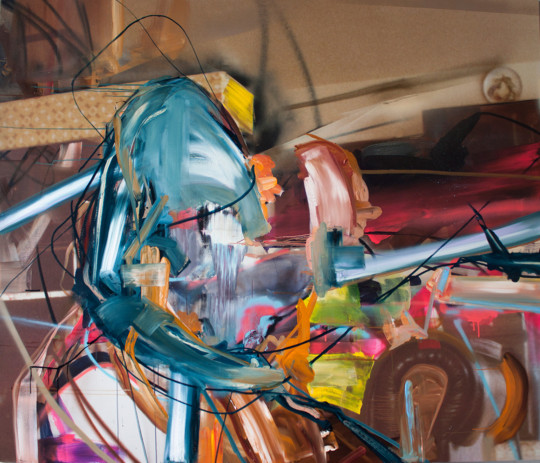
Joshua Dildine, Be First More Often, 2012
PB: I think it's very interesting that you discovered your style in such a serendipitous fashion, and then stuck with it and let it evolve from there on it's own terms. It can be quite hard to comprehend that it all happened on a lark, in a way, and yet now manifest itself in such a powerful and fully fledged way. I'm guessing the only way it could happen like that was because you were open to it, and then when you found it, you stuck with it because you recognized it's potential. For which I applaud you, by the way, because I think your work is brilliant.
Compliments aside, the reason I point this out, is because your work strikes me as being intuitive in many respects, as opposed to calculated, in the sense of you trusting your instincts and going with the flow. I remember seeing an interview you did, where you talked about how your son made some moves on one of your paintings one day while you were out of the studio, but instead of discarding it, you embraced it. I found that anecdote beautiful, but also telling in regards to your process. I think that's a delightful way to approach art, because it allows you to go beyond your own understanding and play with the chaos and randomness of the world in a constructive way.
On that note I'd like to know more about your process, I imagine it can be a bit of a jigsaw puzzle to balance family life with your work as an artist sometimes. How does a perfect day in the studio look like to you? How do you approach the work, and what's your setup like?
JD: My work is a fine balance between spontaneity, intuition, structure, chaos/destruction, and reconstruction. My process is so wrapped up into the way I live my life; This goes back to how I want to keep the work as personal as possible. As a parent, you rely on spontaneity and intuition. For example, if you are getting ready to leave the house, and you realize that your toddler thought it was a good time to make cave paintings in his bedroom... with poop, you have to change plans, be spontaneous, clean it up, be late to where ever you are going, discipline, laugh, learn, and live on. I had the best intentions to leave the house, we eventually left the house, but our destination changed. Connecting poop murals back to my painting: I can have an agenda, I can have set parameters for where I want each piece to go. I am always open to a change of destination. Additionally, I do not think it is about using the photos as a constraint or a restriction on spontaneity. It is more like a play between structure and intuitive choice. The two ideas each have a place in my work, they both exist. As a parent I've learned that situations like these can be multi facetted. Poop murals by a toddler is inappropriate but it can also be funny. They are both allowed to exist in this space. Intuition and structure are allowed to exist in the same space and do so beautifully. Each has influenced the other. The photos have changed and improved the way I paint abstraction just as, I hope, the paintings have improved the space of the photos.
With that said, a "perfect" day in the studio, is when the lawn is mowed, chores are done, bills are paid, all the studio prep-work has been done, and I have zero distractions. The day will start with a cup of coffee, end with a glass of wine. Sure this sounds like a "unicorn" of studio days and completely unrealistic now that I write it out . A great day doesn't have to be a perfect day. I have a lot of great days in the studio. Often those "great" days are realized in hindsight. The distractions from the kids, spontaneous lunch dates with my wife, my pin-striper neighbor stopping by and having painting discussions that are unrelated to art. But, great days must start with a cup of coffee and end with a glass of wine.
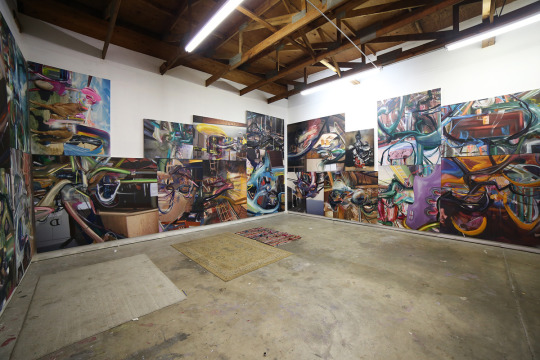
Joshua’s studio, Installation view.
PB: I love it, and thank you for bringing back the nuance, as I realize now how limited the question I posed was. What I mean here, is that I posed it as an "either, or" when in fact, as you point out, it's more of a synthesis between instinct and intellect. Wine and coffee.
I think it would be reckless of me not to get into the aesthetics of your work, now that we're talking. Your work is obviously coming from a very personal place, but when I look at it, it's more of a mystery, like a David Lynch movie. The look of the photographs you use as "backgrounds" send my mind back to film camera's from the 70s, while the strokes you use in the foreground, and the color combinations seems almost futuristic, or at least highly contemporary. It seems you're building on artists like Albert Ohlen and Gerhard Richter in terms of the handling of paint and layering in many ways. Can you talk a little bit about your influences in this area, and what the aesthetics of art means to you in terms of your own work?
JD: My inspiration changes all the time. I try to pull from visual resources that are personal, honest, and current to my state in life. I avidly study current and historic art as well as amateur and commercial artists. The Aesthetics of my pieces predominately respond, and are a departure from, the photographs. Photos from the 80’s with 70’s décor make for interesting color combinations to work with but I love that you picked up David Lynch. I was reading a lot of Frank Herbert and Orson Scott Card, and binge watching seasons of Dr. Who, back when I first started to work on the photographs. So naturally, I responded to that interest. I love the language used to illustrate alternative worlds and alternative space, basically any ideas that take you out of this world.
I think what I find fascinating in science fiction are the familiar themes and vocabulary, that we know, jumbled and placed in a setting that makes us experience something new and unfamiliar. I view my work in a similar way. The painted gesture, to an abstract painting, acts very much like words in a story. Each mark represents different vocabulary. For that reason I am drawn to Albert Oehlen’s work. His work is very “articulate”, there is so much variety in the mark making. I attempt to make my works articulate; there are a lot of different styles of marks through-out each piece, and the result is an altered visual plane of the photograph and painting. Within my paintings, space will expand and collapse, and mass will solidify and vaporize. The way that people move paint fascinates me, and I often look in uncommon places, like seeing a spray paint artist make a space scene using just spray paint with magazine clippings as brushes. I learn a lot from my pin-striping neighbor who approaches painting from a very different perspective. Ultimately, I am a collector of photographs and a collector of visual vocabulary.
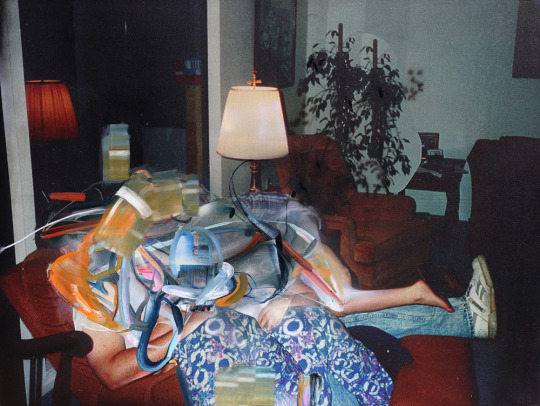
Joshua Dildine, False May Minds, 2015
PB: That’s a great approach, because I think there’s a strong trap-like tendency within contemporary art, because of the rich history of art, to become insular and self-referential. The postmodern Ouroboros. I’m always more interested in the way life itself informs art, like poop murals, pin-striping neighbors, or that time Salvador Dali was sitting at a dinner table, watching a camembert cheese dissolve, which he then connected to Einsteins theory of relativity, and then proceeded to create his iconic painting The Persistence of Memory, portraying melting watches.
In my own work I often portray gold, which is one of the heaviest metals, floating in dreamlike spaces. That antigravitational friction, is something that is quite common in music and dreams. The idea of moving on another wavelength, in another dimension is something that speaks to me on a deep level, because of the transcendentalism it conjures up, and it seems that’s where our interest overlap. Just to tap this vein a little further before we wrap up this interview, I was wondering why you are attracted to this otherworldliness?
The reason I ask is because I’m very curious about the duality in your work of the personal (photography) and the interdimensionality inherent to the forms you introduce through your application of paint on the metaphorical / philosophical level.
JD: Thanks! That is a great question. You are the first to really tap in on that interdimensionality, but, it is definitely there. The sublime is not a new concept to be explored in art. Many abstract painters in particular, recognize that there is something going on beyond them, in those moments lost in painting. The act of painting, for me, as controlled as I can be, has always been somewhat spiritual. I feel like I tap into something that is just out of my reach. Pairing this with the springboard of photographs adds a grounded element that really speaks to the past as a frozen moment in time. Painting feels like a movement outward, toward the future while the act of painting is very present. I am a Christian and I am a contemporary artist. These two identities don’t always seem to blend well in the world that I grew up in and I have, for a long time, wrestled to keep them somewhat separate. Yet, this parallel keeps popping up in my work. Perhaps that duality, inadvertently parallels the painting and photography elements in the work, and the success of the piece depends on the interaction of these two identities.
I am constantly reminded that I am apart of something much bigger than myself. Using photographs, like I said, is a powerful link to a sense of history and legacy. When I use old family photographs I feel a connection with the people in them and the spaces they inhabited. Just the other day, I was looking at old colored slide of my great grandfather, and I noticed that he had the same colored walls and the same type of stains, that could only be caused by a toddler, on those walls. It was profound to see the likeness in our facial features, but even more profound to see those stains on those walls. Yes, that is something subtle and abstract, but there is beauty in spending the time to observe and witness this.
I feel this link strongly as I am living in and remodeling my grandfather’s home. It feels like painting over photos at times, changing the space little bits at a time and thinking of what they might have when the original elements of the home where put in or changed along the way.
Since becoming a father, I have felt more connected to the future, how to foster the potential my children have to leave a positive impact. This is a different kind of legacy. These dualities of past, present and future as well as a physical grounding paired against that otherworldly sublime are the beautiful subtleties of life that I cannot help but see make their way into the work that I do. Not in a contrived way, but in a natural outpouring of reflected life.
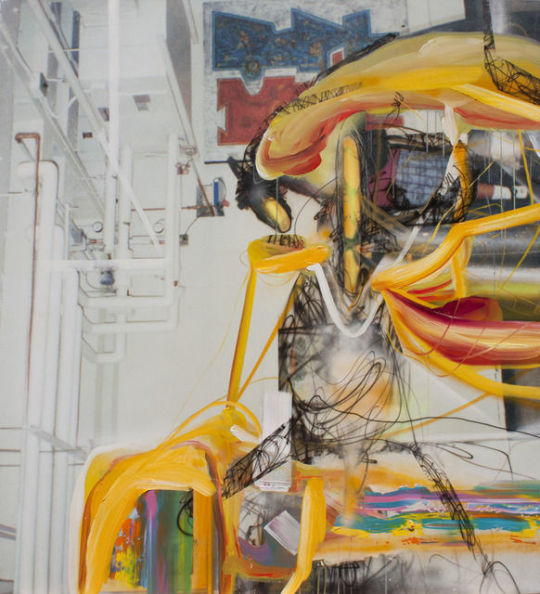
Joshua Dildine, The Games We Play, 2013
PB: I think that's a perfect way to end the interview Joshua, thank you so much for taking the time, as well as opening up. It's been a great pleasure learning more about the deeper levels of your practice.
What are the best ways for me and the readers to stay updated on your work? And do you have any upcoming shows we need to know about?
JD: Thanks Price, It was my pleasure. I appreciated your read into the work that was so intuitive and probing to truly try to understand it at a deeper level.
[email protected] and joshuadildine.com are the best ways to get a hold of, and keep track of me.
59 notes
·
View notes
Text
The Phenomenology of the Music-listening Experience Marian T. Dura
This research is interested in the way it had brought me to think about my work. Often when thinking about music we do not think about its relationship to art as it doesn't have a physical object witch we can identify a meaning too directly. Sound is not an (Art Object) it is a experience that is highly subjective and is due to the disposal of visual hierarchy.
So In my work one can say that my paintings function is to comment of the process of viewing paintings being dominated by the visual phenomena. I suggest that sound as an element of painterly abstraction is fruitful. As the Mind of the artist when producing these aesthetic compositions may be the direct wanderings as it experiences the phenomenon of silence in painting. So thus the sound produced when using a contact microphone in this scenario is the headspace or the aesthetic composition of the artist in time and sound.
The way that I aim to elude to this is through the active procedure of performing the marks and gestures. To not reject abstract expressionism or any historical reference point of my work. But actually to deduct a new movement from this thinking of aesthetics and sound. Similar to the work of sythnesia- but in reverse and in a more literal sense.
“In the phenomenological approach, Smith says, “We let things—including other humans—speak for themselves instead of dictating to them from pre- fabricated cultural and metaphysical categories. Thus instead of trying to cast music in a spatial form, which is visu- ally oriented, we let it speak in its own form.”17 This de-emphasis of the visual in favor of the inclusion of the auditory becomes a major contribution of Smith’s: “In seeking to broaden the spectrum of phenomenology, we thus realize the need to expand its conceptu- ality and language beyond light and sight metaphor. This must then lead to a redefinition of phenomenology in terms of not only phenomena but also of aku- mena”18 (emphasis in original).
2. Aisthesis versus aesthetics. Smith’s appeal for a return to the musi- cal experience itself as a means of dis- covering the inner meaning of music calls for
an overcoming of the merely theoretical and abstract approach to things. For esthet- ics has really been the “metaphysics” of esthesis, that is, it has led us away from the primordial experience of music as such into the realm of intellectualisms, and this under the guise of restoring to musicology some of its lost subjectivity. . . . [T]radi- tional esthetics leads us only to the portals
of a fuller subjectivity, that is, to the begin- nings of a more complete study of the human subject, as musically creative, (whether as composer or performer), and to the musical work as the result of the cre- ativity of the subject. The musical work is thus not an object of art. This connotes a recouping of primordial musical world in which any theory or practice is not the result of speculation about an art experi- ence but in this case emerges from a description of the akumenal experience itself.19 (emphasis in original)
Smith’s statement regarding the musical work as object of art is interest- ing, since it would seem to contradict Dufrenne’s well-known definition of the “aesthetic object,” as he opposed it to the “work of art.” However, this may be only a difference of semantics, since for Smith (as for many other authors), “object” implies a passive thing on which operations are carried out, and the musical work, generated through the creativity of the subject during the musical experience, is so much more than this. Almost possessing a life of its own, it is an integrated subject/object in itself, where notes “put themselves together for us” to perceive and react. This usage is almost the opposite of Dufrenne’s, who considers the work of art the “thing,” and the aesthetic object the product of aesthetic perception, where it “gains a strictly aesthetic, or felt, dimension which it lacked as a work of art.”20
The result of “eidetic reduction” or “cutting through the sedimentation” of aesthetics, says Smith, is aisthesis, a feeling response involving the listener as a totality. This bodily response to music involves the entire individual, since “mind” and “body” are artificial divisions.21″
0 notes